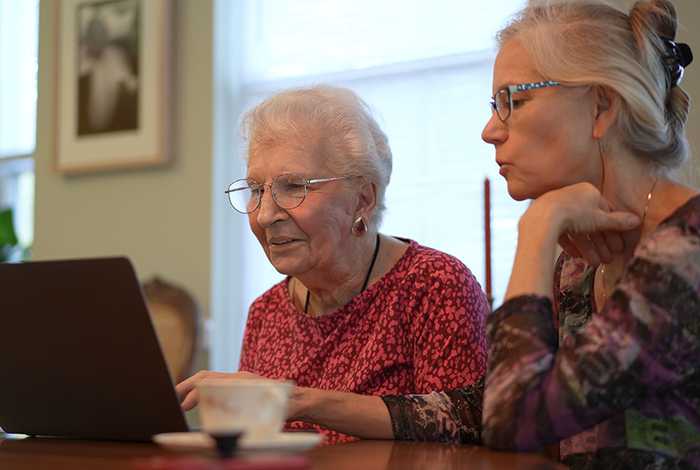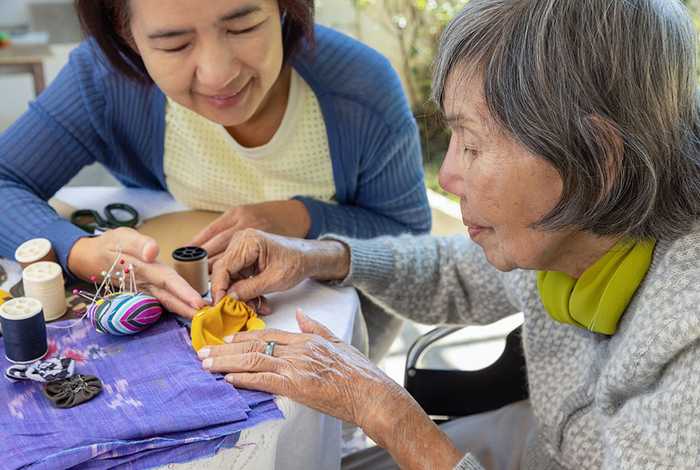Posted by Janine Griffiths
Ultimate guide to jointly owned property and care home fees

Planning for our later years is a crucial step in securing peace of mind, and understanding the financial implications of care is a significant part of that process.
For many, the value tied up in their home is taken into consideration when evaluating care home fees. But what happens when that property is jointly owned?
If you co-own your home, the process of selling it to pay for care is not always straightforward.
The rules differ considerably depending on your specific situation, especially if your partner or another owner still lives in the property. Navigating the complexities of jointly owned property and care home fees is essential to avoid unexpected financial strain.
In this article, we’ll break down how care home fees work when a property is jointly owned, guiding you through the key scenarios and what they mean for you and your family.
The Basics: How Care Home Fees are Assessed
We know that financial assessments can feel overwhelming, so let's start with a simple, plain-English explanation. The system is designed to understand what financial contribution, if any, you can fairly make towards the cost of your care.
In England, Northern Ireland, Wales, and Scotland, this is done through a means test. Think of it as a detailed look at your finances to determine how much help you might need.
This is what a means test considers:
- Savings and income: This includes money in bank accounts, investments, pensions, and any other regular income. The council will add these up to get a full picture.
- Your property: your home may be included in this assessment, but this is not always the case. This is a really important point and where joint ownership becomes critical.
To be eligible for government assistance with care fees in the UK, your capital must be as follows:
England
- Upper threshold (above which you must self-fund care): £23,250
- Lower threshold (below which capital is ignored, i.e. fully supported in principle): £14,250
- Between £14,250 and £23,250: you pay a “tariff” on your capital plus contributions from income.
To learn more about funding thresholds in England, you can read more on GOV.UK.
Northern Ireland
- Upper capital limit: £23,250
- Lower capital limit: £14,250
- Between £14,250 and £23,250: you pay a “tariff” on your capital plus contributions from income.
To learn more about funding thresholds in Northern Ireland, you can read more on the NI Direct website.
Scotland
- Upper threshold (above which you must fund the full cost): £35,500 (as of 7 April 2025)
- Lower threshold (below which capital is ignored): £22,000
- Between £22,000 and £35,500: tariff income applies (£1 of “tariff” per £250 (or part) of capital above the lower limit)
To learn more about funding thresholds in Scotland, you can read more on the care.info website.
Wales
- Upper threshold (for permanent residential care): £50,000
- Below £50,000: capital is ignored (for residential care), but you still may have to contribute from your income.
To learn more about funding thresholds, you can read more on the Welsh government website.
When is your property considered?
This is often the biggest worry for families, so let's clarify. Your property's value will not be included in the means test if at least one of the following people still lives there:
- Your partner or spouse.
- A relative who is aged 60 or over, or is incapacitated.
- Your child (if they are under 18).
If none of these apply, then the value of your share of the property may be counted towards your assets. Don't worry, we'll explore exactly what this means for a jointly owned property in the next section.
The key thing to remember is that the assessment looks at the whole picture - your savings, income, and property to work out the next steps. You are not alone in navigating this, and understanding the rules is the first step towards making a plan.
Jointly owned property: what it means in practice
There are two main ways a property can be jointly owned. The first is as joint tenants. This means both parties own the whole property together, rather than separate shares. If one person passes away, their share automatically transfers to the other, and the property cannot be divided into individual portions.
The second type is tenants in common. Here, each person owns a specific share of the property, which may be equal or unequal. These shares can be passed on to someone else in a will, and they are treated separately in financial matters.
This matters for care fees because the way the property is owned affects how it’s valued in a financial assessment. With joint tenants, the property is generally seen as one asset, while with tenants in common, only the person’s individual share is considered. Knowing which type of ownership applies to your home can give you clarity, reduce uncertainty, and help you prepare for the decisions ahead.
Who pays what?
When you own property jointly, local authorities look at your share (known as your beneficial interest) when assessing care home fees. It is worth noting that they won’t necessarily assume you own half unless that is your actual share (this is because your share might be less, based on contributions or arrangements). However, joint ownership must be assessed and the council should not simply assume joint owners have equal shares.
What if your partner remains in the home?
If you and your partner are separated but continue to live in the same home, it will still be treated as your main residence. This means it is not included in a financial assessment while you remain there. If one of you later moves into a care home, the property is usually disregarded in the means test as long as the other person is still living in it, regardless of your relationship status.
Separate but not living together under joint property ownership
If you have separated from your partner and no longer live together, but still have equal shares in the property, you will be considered to have half of what the property is worth.
12-week property disregard
When you move permanently into a care home, your home (or your share in it) is not counted in the means test for the first 12 weeks. This gives you time to decide what happens next.
Deferred payment agreement
If your home is taken into account in the financial assessment, you may be able to arrange what’s called a deferred payment agreement (DPA), as long as you meet certain conditions.
A DPA can offer real peace of mind. It allows the council to step in and pay your care home fees on your behalf, with the understanding that the costs will be settled later on. Repayment usually happens when the property is eventually sold, or from your estate after you pass away.
This approach gives you breathing space and choice. It means you do not have to face the pressure of selling your home immediately, letting you focus on your wellbeing and adjusting to care without the added stress of rushing big financial decisions.
Practical support for families
When it comes to something as important as jointly owned property and care home fees, the best step you can take is to seek professional advice as early as possible. A solicitor with experience in care funding and property law can help you understand how the rules apply to your specific situation and guide you through decisions that may affect both your home and your future.
It is also wise to contact your local authority at the earliest opportunity. Starting these conversations early can prevent misunderstandings later and gives everyone a clearer picture of what support is available.
Finding a care home
If you are looking for a care home, Autumna can help. You can use the search bar on our website to look for new homes or use our shortlisting tool to do all of the work for you. Alternatively, if you need to talk through your options, our friendly and supportive team are here to help. You can contact them 7 days a week on 01892 335 330.
Receive a Free Care Home Shortlist!
Let our expert team of advisers get your search off to a great start.
Tell us a little about your needs and we'll send you a bespoke shortlist of care homes! Click the button below to begin, it takes just a few minutes.
Other articles to read
From the blog

Older Persons Care Advice
Ultimate guide to jointly owned property and care home fees
September 26th, 2025
Understand jointly owned property and care home fees, how assessments work, and steps to protect your finances and plan ahead with confidence.

Older Persons Care Advice
What are the pros and cons of care homes?
September 26th, 2025
Weigh the pros and cons of care homes to make the right choice for you or a loved one. Discover benefits, challenges, and tips for finding the best fit.

Older Persons Care Advice
Person centred care and dementia: A guide for families
September 23rd, 2025
Discover how person centred care and dementia support go hand in hand. Learn practical tips, expert insight, and guidance for families seeking the best care.
Frequently Asked Questions
It refers to a home owned by two or more people. How it’s owned (joint tenants vs tenants in common) affects how your share is assessed.
Your share may be counted unless a partner, child under 18, or a relative over 60 or disabled continues living there.
When you move permanently into a care home, your home or your share is ignored in the means test for 12 weeks, giving time to decide what happens next.
A DPA lets the council pay your care fees temporarily, with repayment later from your property sale or estate, so you don’t have to sell immediately.
Yes. Consulting a solicitor early and contacting your local authority promptly ensures you understand your rights, options, and any financial implications.
The UK's largest & most detailed directory of elderly care and retirement living options
10,318
Care Homes
11,950
Home Care Services
1,657
Live-in Care Services
1,756
Retirement Living Developments
Autumna is the UK's largest and most comprehensive later-life living & elderly care directory. Our detailed search facility and team of expert advisors can help you find the best care homes, nursing homes, retirement homes, retirement villages, home care, and live-in care services for you or your loved one's needs. Our website is free to use, we are proudly independent, and we never take referral fees.






